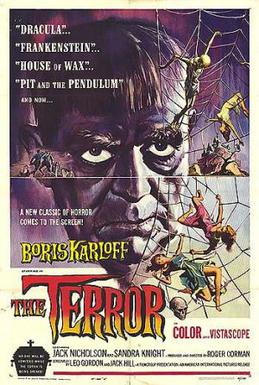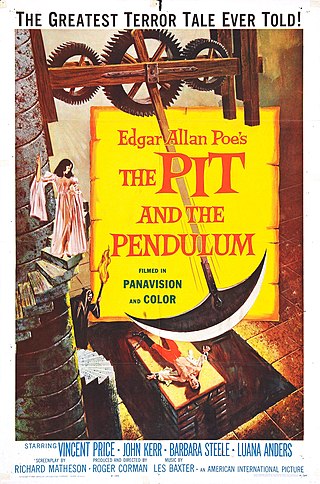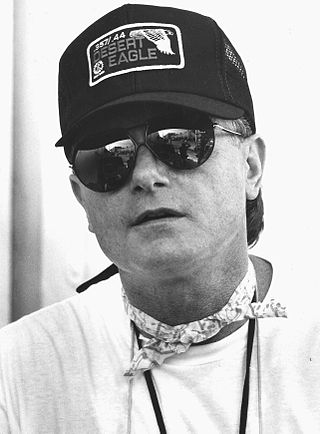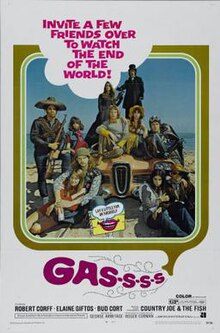
Roger William Corman is an American film director, producer, and actor. Known under various monikers such as "The Pope of Pop Cinema", "The Spiritual Godfather of the New Hollywood", and "The King of Cult", he is known as a trailblazer in the world of independent film. Many of Corman's films are low-budget cult films including some which are adapted from the tales of Edgar Allan Poe.
American International Pictures LLC is an American film production company owned by Amazon MGM Studios. In its original operating period, AIP was an independent film production and distribution company known for producing and releasing films from 1955 until 1980, a year after its acquisition by Filmways in 1979.

The Fast and the Furious is a 1954 American crime drama B movie starring John Ireland and Dorothy Malone, co-directed by Ireland and Edward Sampson.

The Trip is a 1967 American psychedelic film released by American International Pictures, directed by Roger Corman and written by Jack Nicholson. It was shot on location in and around Los Angeles, including on top of Kirkwood in Laurel Canyon, the Hollywood Hills, and near Big Sur, California, over three weeks in March and April 1967. Peter Fonda stars as a young man who experiences his first LSD trip.

It Conquered the World is an independently made 1956 American black-and-white science fiction film, produced and directed by Roger Corman, starring Peter Graves, Lee Van Cleef, Beverly Garland, and Sally Fraser. It Conquered the World was released theatrically by American International Pictures as a double feature with The She-Creature.

The Undead is a 1957 horror film directed by Roger Corman and starring Pamela Duncan, Allison Hayes, Richard Garland and Val Dufour. It also featured Corman regulars Richard Devon, Dick Miller, Mel Welles and Bruno VeSota. The authors' original working title was The Trance of Diana Love. The film follows the story of a prostitute, Diana Love (Duncan), who is put into a hypnotic trance by psychic Quintus (Dufour), thus causing her to regress to a previous life. Hayes later starred in Attack of the 50 Foot Woman (1958). The film was released on March 15, 1957 by American International Pictures as a double feature with Voodoo Woman.

The Terror is a 1963 American independent horror film produced and directed by Roger Corman. The film stars Boris Karloff and Jack Nicholson, the latter of whom portrays a French officer who is seduced by a woman who is also a shapeshifting devil.

Sorority Girl is a 1957 film noir exploitation film directed by Roger Corman. It stars Susan Cabot as Sabra, a sociopath who plays a very disruptive role in a sorority, with Barboura Morris as Rita, and Dick Miller and June Kenney. It was released by American International Pictures as a double feature with Motorcycle Gang.

The Pit and the Pendulum is a 1961 horror film directed by Roger Corman, starring Vincent Price, Barbara Steele, John Kerr, and Luana Anders. The screenplay by Richard Matheson was loosely inspired by Edgar Allan Poe's 1842 short story of the same name. Set in sixteenth-century Spain, the story is about a young Englishman who visits a forbidding castle to investigate his sister's mysterious death. After a series of horrific revelations, apparently ghostly appearances and violent deaths, the young man becomes strapped to the titular torture device by his lunatic brother-in-law during the film's climactic sequence.
Stephanie Rothman is an American film director, producer, and screenwriter, known for her low-budget independent exploitation films made in the 1960s and 1970s, especially The Student Nurses (1970) and Terminal Island (1974).

George Brendan Armitage is an American film director, screenwriter and producer. He directed the films Miami Blues (1990) and Grosse Pointe Blank (1997). He worked frequently with Roger Corman.

Five Guns West is a 1955 Western film set during the American Civil War directed by Roger Corman. It was Corman's first film as director although he had already made two as producer. It was the second film released by the American Releasing Company, which later became American International Pictures.

Apache Woman is a 1955 American Western directed by Roger Corman and starring Lloyd Bridges. It was Corman's second film as director, following Five Guns West. It was one of four Westerns he made for American International Pictures, the other being Five Guns West, The Oklahoma Woman (1955) and Gunslinger (1956). Corman says Apache Woman and Oklahoma Woman were from ideas by AIP whereas the others were his ideas. This was the first film from Golden State Productions, a company headed by Alex Gordon.

Naked Paradise is a 1957 drama film directed by Roger Corman. It stars Richard Denning and Beverly Garland.

The Saga of the Viking Women and Their Voyage to the Waters of the Great Sea Serpent is a 1958 American action-adventure horror film directed by Roger Corman. It stars Abby Dalton, Susan Cabot and June Kenney.

Hit Man is a 1972 American crime film directed by George Armitage and starring Bernie Casey, Pam Grier and Lisa Moore. It is a blaxploitation-themed adaptation of Ted Lewis' 1970 novel Jack's Return Home, more famously adapted as Get Carter (1971), with the action relocated from England to the United States.

The Wild Racers is a 1968 American film directed by Daniel Haller and starring Fabian, Mimsy Farmer, and Judy Cornwell. The screenplay concerns a Grand Prix racing car driver.

Private Duty Nurses is a 1971 American film written and directed by George Armitage. It is a sequel to The Student Nurses (1970) for New World Pictures. Roger Corman says they got the idea for the title after being sent a letter of complaint about the first film from the Private Duty Nurses Association.

Dance of the Damned is a 1989 American film directed by Katt Shea and executive produced by Roger Corman.

Splatter is a 2009 interactive short horror web series directed by Joe Dante produced by Roger Corman and starring Corey Feldman. It was created for Netflix.


















